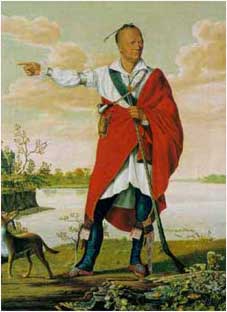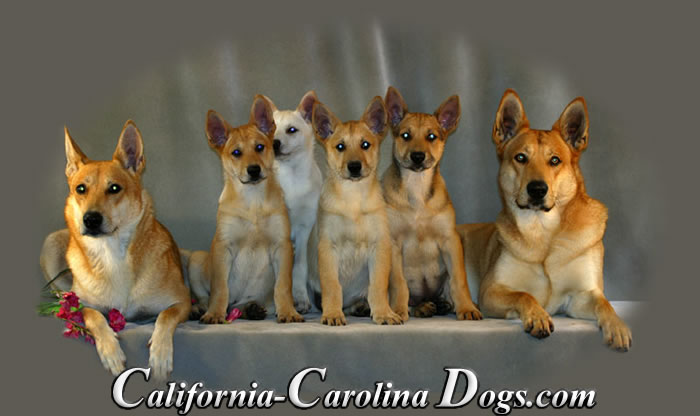“Tracking America's Native Breed”
Copyright 1999 Smithsonian Magazine
All photos by Lynda Richardson
ARTICLE PAGE 1 2 3 4 5
On an oppressive June evening, with the temperature still above 100 degrees Fahrenheit and the sun a fierce red ball in the western sky, I walk with Bris and a dozen or so Carolinas across Banbury Cross Farm, near Aiken. The dogs lope easily ahead of us, the low sun backlighting them, creating little moving nimbi of gold. Billy Morgan Benton, a big, outgoing man with dark hair slicked back wet under his cap, whistles to his pack, he and farm owner Jane Gunnell breed the dogs here, working with Brisbin to establish the Carolina dog as a domestic pet. They are frolicsome, friendly animals, Gunnell says, but out in the wooded nooks and weedy fields of the farm, their primitive traits become obvious.
The dogs are ginger, a red-brown that fades to pale buff on the flanks and belly, the same color as fallen pine needles and dead grass. They fan out through a low scrubby field, moving into the damp breeze, zigzagging and coursing with their noses low and their curved tails at half-staff.
Suddenly one dog makes a sidestep, its supple neck arching; the tail snapping high, the longer, whiter hairs along its underside flaring, reminding me of a deer. The effect on the rest of the pack is electric. Within seconds, all the dogs converge on the spot, tails moving like semaphore flags. One plunges its head into the grass with the speed of a heron's stab, but it misses. Something small skitters through the weeds, and another dog leaps, coming down with mouth and front feet together, a predatory exclamation mark-Bam! There is a tiny squeak, and the mouse vanishes in one gulp. "I would suggest that you're watching a reenactment of a dog pack out hunting 8,ooo years ago," Brisbin says. While he doesn't claim that Carolina dogs are direct, genetically pure descendants of the original dogs that crossed the land bridge, he believes that they re-create their look and behavior. "The Carolina dog is a hypothesis, he says. "A hypothesis that there still exists in certain parts of the United States, most likely in relative uninhabited broad expanses of natural habitat within the Southeast, remnant groups of dogs whose morphological, behavioral, ecological and genetic traits my approximate those of the first dogs to enter North America.
"It's all part of the package. Morphology and behavior go hand in hand," Brisbin says, gesturing to the lean shape of a nearby dog snuffling through the underbrush. That sinuous, blue-heron neck doesn't seem relevant without the pointed muzzle for stabbing at prey, and the upright ears for sharp hearing, and the long tail with its pale underside for signaling to the rest of the pack. Whether the Carolina dog is an ancient holdover or a modern throwback, its shape and behavior make a lot of evolutionary sense.

Genetics may tease out the origins of the Carolina dog, but so far the results are mixed. Recently, Brisbin and his colleague Travis Glenn, a molecular geneticist at SREL, have been looking at the mitochondrial DNA (mtDNA)of Carolina dog--the genetic material passed down through the matemal line, and a potent gauge of relationships among animals. When the mtDNA from Carolina dogs, dingoes, singing dogs and a variety of domestic breeds are compared, a phylogenetic tree-a sort of family tree showing their relationships-can be made. In this tree, the Carolina dogs tended to clump together near the base, an intriguing though tentative result that suggests the Carolina dogs may possess primitive genetic traits.
"Most of the dogs coming out at the base of the tree are Carolina dogs or dingoes," Glenn says. "If there were no basis to the argument that Carolinas are primitive, they'd be all over the tree, but they're grouped together." Glenn, who had initially assumed the Carolinas were just domestic dogs, admits he was stunned when he saw the results. "I had to go out for a beer."
Brisbin is cautious in interpreting the results, especially since the mtDNA sequences of some domestic dogs also grouped with the Carolinas at the base of the tree. "It's interesting that at a preliminary stage, most all of the Carolina dogs turned out to be primitive"-but so did boxers, German shepherds and Labrador retrievers, among others. It will take more research to sort out exactly what secrets are hiding in the "yaller" dog's genes.
NEXT PAGE